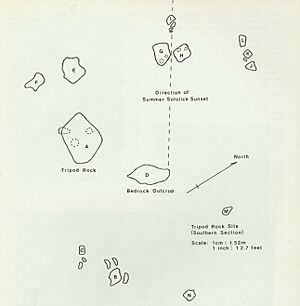Tripod Rock facts for kids
Tripod Rock is an amazing balancing rock found in the town of Kinnelon, New Jersey. It's located in a special place called the Pyramid Mountain Natural Historic Area. This giant rock, which weighs many tons, is made of a very old type of rock called gneiss. It sits right on the edge of a long ridge, balanced carefully on three smaller rocks.
Tripod Rock is about 6 meters (20 feet) long, 3 meters (10 feet) wide, and 2.5 meters (8 feet) high. It weighs around 127,000 kilograms (280,000 pounds)! Imagine a rock that heavy! It has a cool triangular shape on its top. The three smaller stones that hold it up are about 1 meter (3 feet) wide. They lift the huge rock about 0.5 meters (1.6 feet) off the ground. The way the big rock touches its support stones forms a shape like a 3-4-5 triangle.
Contents
What Makes Tripod Rock Special?
Tripod Rock is a type of rock called a glacial erratic. This means it was moved and left behind by a giant glacier long, long ago. Even though it looks like it could fall, it's been sitting there for a very long time!
Nearby Rocks and the Summer Sun
About 12 meters (40 feet) away from Tripod Rock, there are three other boulders that look like they form a triangle. Two of these bigger boulders are also balanced on smaller stones. The third rock, called the "apex rock," is about 3 meters (10 feet) to the northeast.
If you stand near Tripod Rock and look through these two large boulders, the apex rock points to the next ridge in the distance. This line of sight points exactly to where the sun sets on the summer solstice. The summer solstice is the longest day of the year, usually around June 21st.
In the early 1980s, people studied Tripod Rock and the stones nearby. At that time, you could clearly see the spot on the ridge where the sun set on the summer solstice. This was because gypsy moths had eaten many leaves from the trees, making it easier to see far away. There was a large boulder on that ridge where the sun set. Sadly, a house was built there within a year, and the boulder was moved by big machines. Today, you can still see the summer solstice sunset near the edge of that house, but it's not as clear as it used to be.
Other Interesting Rocks Nearby
There are two smaller balancing rocks northeast of Tripod Rock. These rocks are about 1 to 3 meters (3 to 10 feet) wide. People haven't found any special calendar alignments with these smaller rocks.
Tripod Rock sits on a ridge that looks down into a long valley. In that valley, near a small stream, is another huge glacial erratic called Bear Rock. In the 1800s, people dug around Bear Rock to find old artifacts. Some of these ancient tools and items are now kept in museums! Bear Rock also has a large overhang, which means it might have been used as a rock shelter by early people.
Could Tripod Rock Be a Solar Observatory?
Even though there's no proof that people ever used Tripod Rock to watch the sun, it could work like a simple solar observatory. If a small part of the ridge across the valley was kept clear of trees, you could use Tripod Rock to track the sun's movements. Most scientists believe Tripod Rock is a natural formation, a huge rock left behind by a glacier in a very unusual balancing position.


